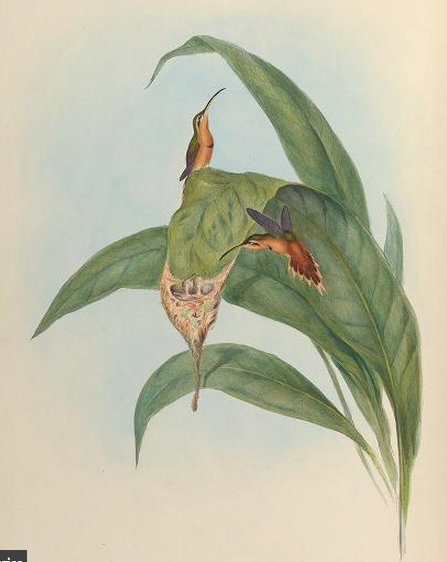I knew in advance how this one was going to work out: the OED would lead me to the earliest citations for the English hummingbird label “hermit,” and a little bit of e-drudgery would let me push the name back to its apparent source, probably among the French trochilidistes of the early nineteenth century. And along the way, perhaps I would find an unexpected motivation for the now opaque metaphor that compares these birds to the early desert ascetics.
That, after all, is how scholarship works — even when it comes to so trivial a question as that and so ephemeral a medium as this.
Well, not always. In this case, the citation hunters in Oxford fail us. The French ermite appears to be modeled on the English hermit. And if we trust John Gould, the name seems to be due entirely to the bird’s
frequenting the darkest and most retired parts of the forest … affecting dark and gloomy situations.
As far as I have been able to discover, it was Gould who introduced the name to ornithology. Interestingly, though, he makes no claim to originality: Gould’s Introduction to the Trochilidae expressly says that these hummingbirds, “remarkable for being destitute of metallic brilliancy,” are “popularly known by the name of Hermits.”
I was surprised to learn that hermits were “popularly known” at all in the English-speaking world of the mid-nineteenth century. As it turns out, though, Gould wasn’t referring to the streets of London. In the 1849 description of Phaëthornis eremita, he explains the source of the species epithet (later elevated by Reichenbach to generic status): this bird, he writes, is the
Little Hermit of the collectors of Para
in Brazil. And just who were those collectors?
The residents of many parts of Brazil employ their slaves in collection, skinning, and preserving them for the European market; and many thousands are annually sent from Rio de Janeiro, Bahia, and Pernambuco.
One segment of the clientele didn’t care much for dull hummingbirds, though: the Brazilian collectors
also supply the inmates of the convents with many of the more richly coloured species for the manufacture of artificial-feather flowers.
It is my guess — an especially safe guess, given that it can never be tested or disproved — that the Luso-Brazilian “eremita” originated at the door of one of those monasteries, where a monk or a nun declined to pay for a brown hummingbird, rejecting it as too drab, like the sackcloth-clad hermits of the wilderness, what Alfred Newton would later call “the russet-clothed brotherhood.”



